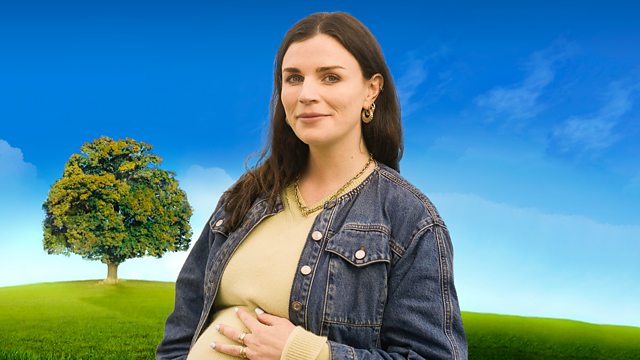
Aisling Bea
Comedian Aisling Bea finds moments of genuine connection in her family tree, with stories of female resilience and a relative who fought for Irish independence and culture.
Award-winning actor, screenwriter and comedian Aisling Bea is heavily pregnant and keen to find out about previous generations before she gives birth to the next.
With a strong suspicion that all roads will lead to Ireland, she starts her investigation by visiting her mum and aunt in County Laois, not far from where Aisling grew up in County Kildare. Aisling’s father died when she was three; with her mum and aunt, she looks at a photograph of her dad’s grandfather, her great-grandfather Pádraig O’Briain. Pádraig was a young man during the first decades of the 20th century - a turbulent period in Irish history as it fought for independence from Britain. Aisling wants to know if Pádraig was involved.
Turning to her mum’s side of the family, Aisling recalls how her childhood was dominated by strong women, but where did this independent spirit come from? The family have already traced Aisling’s maternal Sheehy line back several generations; they came from County Limerick, so this is where Aisling heads next.
In County Limerick, Aisling meets historian Dr Richard McMahon, who has some intriguing documents. Aisling learns that her three-times great-grandparents James and Martha Sheehy were substantial farmers in the area, which gave them a decent income and social standing in the community. A newspaper article reveals that the Sheehys were the victims of a violent crime: a group of men broke into their property, destroyed farming equipment, robbed arms and money from the house, and attacked Aisling’s three-times great-grandfather. Richard tells Aisling that the nature of the attack means it’s quite likely to have been motivated by economic grievance rather than just robbery. Aisling learns that James died as a result of his injuries, leaving her three-times great-grandmother Martha a widow with a family to support.
Letters from Martha to the Lord Lieutenant General, Governor of Ireland, show Aisling’s three-times great-grandmother begging for financial help, with no success. These letters date from just before the Great Famine, and Aisling is worried that things do not look good for Martha and her family. However, documents from the early 1850s - a few years after the famine - tell a different story. Martha has substantially increased the amount of land she leases. While many poor tenant farmers were pushed off the land, Martha took advantage of the situation to increase her holdings. For Aisling, this is difficult to reconcile; she admires Martha’s tenacious ability to survive and provide for her family, but is also conflicted by learning that her family flourished during a period of extreme deprivation and devastation for many people in Ireland.
Aisling now wants to investigate her father’s side of the family, and to do this she heads to County Kerry on the south west coast of Ireland. Knowing that her great-grandfather Pádraig lived in a town called Ballyferriter, she goes to the old school to meet historian Dr Daithí Ó Corráin. A census returns offers a clue as to Pádraig’s sympathies at the time: he is one of only a handful of men who fill in the form in Irish. At the time, English was the official language, and this was a subtle but powerful expression of dissent.
Aisling goes on to discover that her great-grandfather was involved with the early Irish independence struggle. During World War One, he was part of a group who planned a nationwide uprising. A series of mishaps meant the uprising failed to materialise anywhere other than Dublin, but for Aisling, Pádraig’s willingness to risk everything for Irish independence is inspiring. She goes on to learn that he spent the rest of his life campaigning for the Irish language to be taught in schools and used in public life. Aisling is moved to discover that, before he died, a lot of his campaigns had born fruit; Irish language articles appeared in newspapers, and teaching the Irish language was adopted in schools.
For the final stage of her journey, Aisling finds out about Pádraig’s mother-in-law: Aisling’s great-great-grandmother, Anne O’Donoghue. Like Pádraig, Anne was a schoolteacher, and at the age of 19 was stationed on the remote Blasket Islands, three miles off the west coast of Ireland. Author Felicity Hayes-McCoy shows Aisling a memoir by Tomás O’Crohan. Tomás grew up on the island and was a young boy in the school where Aisling’s great-great-grandmother taught. He describes how the children couldn’t understand what she said, having never heard English before, but talks with fondness of the young school mistress, recounting how she returned to the mainland and married but never gave up her profession as a schoolteacher.
Aisling ends the film thinking about how many of the things she cares passionately about - Irish history and culture, feminism and women’s voices - have been so present in her family tree. She reflects on how lucky she’s been exploring this journey while about to create her own next little line.
On TV
Credits
| Role | Contributor |
|---|---|
| Presenter | Aisling Bea |
| Director | Helen Simpson |
| Producer | Henry Ajayi Ward |
| Series Producer | Lucy Swingler |
| Executive Producer | Colette Flight |
| Production Manager | Demi McGarrell |
| Production Company | Wall to Wall Media |
